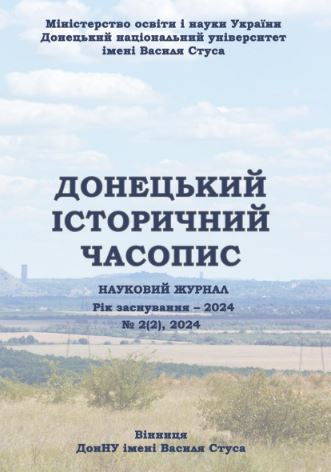The Boikivske community architecture landmarks that survived conventional and information warfare
DOI:
https://doi.org/10.31558/3083-5771.2024.2.11Keywords:
architecture, Donetsk oblast, information warfare, history of culture, history of Ukraine, auxiliary sciences of historyAbstract
The aim of the paper, based on the analysis of literature and sources, is to present a currently identifiable image of the development of architectural landmarks in the settlements of the Boikivske village community of the Kalmius district in the Donetsk region of Ukraine, while identifying and analyzing the reasons for the current state of historicalarchitectural space of the district existing as it is. The analysis covers 19th–20th centuries’ architecture, when the region was under the control of the Russian Empire, and then the Soviet Union. Methodologically, the research is primarily based upon content analysis of materials such as data pieces and photography found on various online platforms (Google Map, Yandex Maps, along with a number of local websites, including under the control of the information warfare hybrid adversary) and news website reports on war events, which may have affected the architectural landmarks. The secondary sources amongst the material base were amateur travel blogs and websites on local lore and culture of the region, alongside websites of religious organization.
The results of the study reveal that neither the Russian Imperial, nor the Soviet government cared much for the development of eye-pleasing and historically-enduring architecture in what would become the Kalmius region, and the few historical buildings that remain standing are those that survived out of convenience, sturdinence, and continued use by governments. The only exception to that principle are the religious structures, which were maintained by the churches, including the oldest structure in the district, but even in their case government bias interfered greatly with the safety of buildings: Soviet anti-religion policies led to the destruction of a number of original churches, necessitating recreation in the 21st century.
The research is fully original and belongs to the author; it is mostly based on the materials that have been personally found or seen by the author in primary sources, all secondary sources are referenced separately. From the practical point of view, the results fully demonstrate how government bias, goals, and perceived needs influence the development of architecture. It also factors into information warfare trends, wherein the removal of German population from today’s Boikivske community “coincided” with the removal of characteristic architecture (or, in the case of the abandoned dairy plant, a remodeling of it), completely changing the historical cultural landscape and the memorial space of the district. Thus, the research’s materials have a certain use for historians of culture, architects, and government employees overseeing memorial spaces. Prospects for further research on the topic include the historical architecture remaining in the Kalmius district may either confirm the trends seen in Boikivske, or show otherwise. Furthermore, the article contains archival and visual materials, first introduced to academic use.
References
Istoryko-kulturna spadshchyna Donechchyny: istoriia, vtraty, vidnovlennia (2023). Pro Proiekt. Istoryko-kulturna spadshchyna Donetskoi oblasti: dokumentuvannia vtrat i perspektyvy vidnovlennia – Historical and cultural heritage of Donetsk region: documentation of losses and prospects for restoration. Retrieved from https://heritage-of-donetsk.org/about. html [in English].
IWM (2023). Nadiia Temirova. Documenting Ukraine / IWM. Retrieved from https://www.iwm.at/documenting-ukraine/grantees/nadiia-temirova [in English].
Kazanskoi Bozhoi Materi parafiia UkrainskoI Pravoslavnoi tserkvy Kyivskoho patriarkhatu (2024) [Kazan Mother of God Parish of the Ukrainian Orthodox Church of the Kyiv Patriarchate]. UA Region. Retrieved from https://www.ua-region.com.ua/ru/24162776 [in Ukrainian].
Knyha prykazov dyrektora maslozavoda 1945–1946 hh. (1946) [Book of the orders of the dairy plant director 1945–1946]. Arkhivnyi viddil administratsii Telmanivskoho raionu. Fondy likvidovanykh pidpryiemstv periodu nezalezhnosti. – Archive Department of the Administration of Telmanove District. Series on liquidated enterprises of the period of independence (Series 166, Box 1-L; Folders 1, 2), Boikivske, Ukraine [in Russian].
Kod YeDRPOU 24317374 ZAT «Telmanivskyi molzavod» Dyrektor Volobuiev Hennadii Herasymovych (2024). [Unified State Registry Code 24317374 closed joint-stock company “Telmanove dairy plant” Direktor Volobuiev Hennadii Herasymovych]. Open-databot. Retrieved from https://opendatabot.ua/c/24317374 [in Ukrainian].
Kozlenko, D. (2011). Zhyvyie rodnyky Donbassa [The Living Springs of Donbas]. Donetsk: istoriia, sobytiia, fakty – Donetsk: history, events, facts. Retrieved from https://opendatabot.ua/c/24317374 [in Russian].
Admin (2011). Tselebnyi istochnyk v Konkovo (chast 1) | Healing Spring in Konkovo (part 1). Donbass y Pryazove: turyzm, otdykh, puteshestvyia – Donbas and Pryazovia: tourism, vacations, travels. Retrieved from https://opendatabot.ua/c/24317374 [in Russian].
Maksym1991 (2014). Ylliustratyvnyi atlas Telmanovskoho raiona Donetskoi oblasty [Illustrative atlas of the Telmanove district of Donetsk region]. SlideShare. Retrieved from https://www.slideshare.net/slideshow/telmanovskiyrayonatlasend/35260654 [in Russian].
Martynchuk, I. I., Otzemko, O. V. & Temirova, N. R. (2021). Memorialni vymiry Donetska [Memorial dimensions of Donetsk]. International scientific and practical conference «History, political science, philosophy and sociology: revolutionary changes»: con-ference proceedings, May 28–29, 2021. Wloclawek, 19–23 [in Ukrainian].
Mieliekiestsev, K. I. (2021). Emblematika postradianskoii Donechchyny: ofitsioz “hospodarnukiv”, pererobky “z narodu”, alternatyvy apolohetiv “russkoho mira” [Em-blematics of the post-Soviet Donetsk region: official ones “from the bossmen”, upgrades “from the people”, alternatives from the “Russian world” supporters]. Naukovi zapysky Vinnytskoho derzhavnoho pedahohichnoho universytetu imeni Mykhaila Kotsiubynskoho. Seriia: Istoriia: zbirnyk naukovykh prats – Scientific notes of Mykhailo Kotsiubinskyo Vinnytsia State Pedagogical University. Series: History: collection of scientific pa-pers, 35, 58–66. [in Ukrainian].
Temirova, N. R. (2020). Formuvannia monumentalno-memorialnoho prostoru Donetska. Visnyk KhNU imeni V. N. Karazina. Seriia «Istoriia» – Bulletin of the V. N. Karazin KhNU. Series “History”, 57, 175–189 [in Ukrainian].
Schreck, C. (2019). From ʽNot Us’ To ʽWhy Hide It?’: How Russia Denied Its Crimea Invasion, Then Admitted It. Radio Free Europe/Radio Liberty. Retrieved from https://www.rferl.org/a/from-not-us-to-why-hide-it-how-russia-denied-its-crimea-invasion-then-admitted-it/29791806.html [in English].

